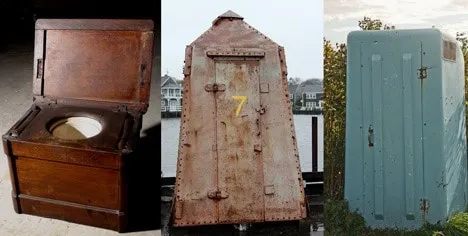The Portable Toilet industry began for shipyard employees in the 1940s
The portable toilet story begins during World War II, when the owners of the shipyards in Long Beach, New Jersey realized that the employees were losing a lot of valuable work time in the long trek from the ships back to the docks to answer nature’s call.
According to the Minneapolis Porta Potty Pros, they decided to construct small, portable cubicles that were made with wood or metal, that contained a small holding tank.
As a result, more work got done, workers were happier, and the portable toilet industry was birthed.
Invention and Evolution of Portable Restroom Deodorizer
Portable Restroom Deodorizer or the “blue liquid” in porta potties was invented decades ago and was a huge leap for the portable restroom industry. The first restroom deodorizers were formaldehyde based chemical blends that helped cover up waste, mask bad odors and help keep portable restrooms clean.
Recently the industry has moved to non-formaldehyde based deodorizers since local wastewater treatment plants can’t process them as easily. This new round of deodorizers contains biocides that inhibit the growth of odor-producing gram-positive bacteria. This means they’ll keep the odor causing bacteria from multiplying, which keeps the smell to a minimum.
The Portable Restroom Renaissance
Around the 1970’s there were a series of portable restroom modernization’s that greatly improved the cleanliness, transportation and experience. The first of these inventions were the fiberglass portable restroom. This switched the restroom materials from wood and metal to the lighter fiberglass material. Fiberglass made the porta potties easier to move and clean, but there was a trade off. Fiberglass was a fragile material, which meant the restrooms were prone to breaking. The material also absorbed odors, causing them to capture bad smells and hold onto them.
Shortly after the invention of the fiberglass restroom, the polyethylene portable restroom was first put on the market. In the 1960’s a patent was issued to George Harding, co-founder of PolyJohn Corporation, for a polyethylene portable restroom. These restrooms hit the market in the 1970’s and were much more durable, lighter and easier to move than their fiberglass competitors. These are probably the portable restrooms that you’re used to today. Polyethylene restrooms are more resilient and their useful life can be over 10 years. This allowed for portable restroom providers to expand their fleet and their businesses.
These polyethylene restrooms are also assembled from several different parts, which made it much quicker and cheaper for portable restroom manufacturers to get their restrooms across long distances to local restroom providers. It also made it easier to swap out damaged parts to prolong their useful life.
Luxury Restroom Trailers Hit the Scene
Some of you may not know this, but luxury restroom trailers are now a thing for the portable restroom industry! These portable restrooms having flushing restrooms, running water sinks and, sometimes, even heating and air conditioning in them. These bathroom trailers first came on the scene in 1984, when PolyJohn built their first trailer in Columbus, OH.
The original trailer was an eight-stall trailer with three urinals and was a whopping 32 ft. long. In 1988 PolyJohn started Ameri-Can Engineering and in 1990, Ameri-Can became its own separate company. Soon after Ameri-Can broke off, there were three restroom trailer manufacturers on the scene including Olympia and Advanced Containment System. Today there are over 19 manufacturers of luxury restroom trailers around the world, and the trailer has become a staple at special events, weddings and construction sites everywhere.

